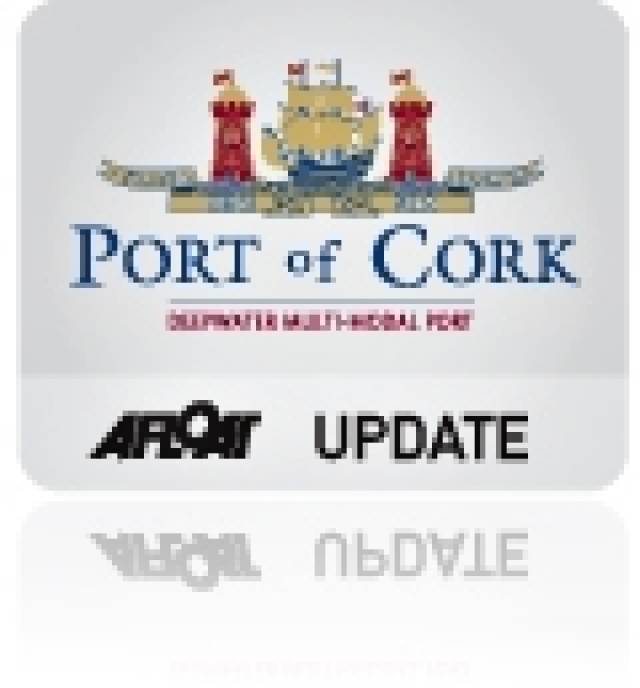#portofcork – Total traffic through the Port of Cork in 2013 reached 9.1 million tonnes compared to 9.05 million tonnes in 2012. Like most Ports worldwide, the Port of Cork has experienced very challenging trading conditions in 2013, however some cargos have shown an increase compared to 2012 levels and this is very encouraging, according to the Port of Cork.
Container volumes through Tivoli Container Terminal were up compared to 2012 figures, and Ringaskiddy Container Terminal showed an increase in both imports and exports. This increase in Ringaskiddy is predominantly down to Fyffe's banana trade handled under contract with Maersk Line, which was established in 2012. This service, the first scheduled deep sea transatlantic service from Central America to Ireland, has opened up trading and logistic opportunities for many of Ireland's imports and exports to the Caribbean.
Oil traffic through Whitegate Oil Refinery, currently owned and operated by Phillips 66 continues to have a significant impact on the overall traffic through the Port of Cork. Imports are showing similar levels to 2012 while exports are marginally down.
Non-oil traffic has seen an increase of over 5.9% in imports of animal feed, cereal and fertiliser.
Speaking about the end of year trade traffic results, Chairman John Mullins said: "Despite challenging trading conditions worldwide, the Port of Cork saw increases in certain trades in 2013. These increases, while marginal, are encouraging and show the emergence of the economy as Ireland slowly begins to recover. Ports play a vital part in this recovery and the Port of Cork is a vital trading link to the success of Ireland and in particular the Munster region."
He continued: "The Port of Cork has achievable plans for 2014 in terms of future port infrastructure development and these plans were further endorsed in 2013 with the allocation of TEN-T funding, funding which positions the Port of Cork as a priority TEN-T Core Network port."
The Port of Cork as a Tier 1 National Strategic Port plays a key role in the movement of goods to and from European and World markets. The port secured funding as part of the TEN-T programmes which now positions the Port of Cork as a priority TEN-T Core Network port. This foundation block will drive the Port to meet future connectivity needs and supports the development of the wider regional and national economy. This TEN-T funding is of key importance to the port
The Port of Cork cruise business continues to grow year on year and 2013 was no exception. 62 cruise liners called to Cork in 2013, bringing a staggering 123,000 passengers and crew to the region. These transit visitors are a welcome economic stimulus for Cork, bringing a much needed boost to the local economy for eight months of the year. Brittany Ferries had an excellent year with their seasonal service from Cork to Roscoff carrying over 79,000 passengers in 2013. This figure is up on 2012 and there is an expectation that 2014 will be another busy year for Brittany Ferries.
Looking forward, the Port of Cork will lodge a planning application in April 2014 with An Bord Pleanála for new and improved port infrastructure in Ringaskiddy. As part of this planning proposal, the Port of Cork will engage with stakeholders to allow for feedback to be given on the proposal. The Port of Cork is confident that this planning proposal will succeed; allowing the port to enhance its competitiveness and offer improved facilities to port customers, and bring a much needed stimulus to the local economy.
Following a decision by the Department of Transport, Tourism and Sport under Minister Leo Varadkar, the responsibility of the management and control of Bantry Harbour was transferred to the Port of Cork Company on the 1st January 2014. Through its subsidiary Bantry Bay Port Company, the Port of Cork looks forward to the development of business through this port.
The Port of Cork is committed to seeking out new business opportunities for the port and in particular, the agri-food business will be a key sector which the Port of Cork is keen to develop.
John Mullins says: "The Agri sector presents huge opportunities for the port's exports, with the lifting of the Common Agriculture Policy production limits in 2015."
Another area which proved successful in 2013 and one which the port will be actively progressing, is the offshore supply services and renewable energy sector. The Port of Cork is experienced in handling large project cargo and has been at the forefront in offering services in the exploration and development needs of the various multi-national companies in this sector.
Details of sister seaport agreements between Port of Cork and PortMiami and the Port of Cork and Port of Shenzhen were announced in 2013. These seaport agreements will benefit the Port of Cork by increasing the exchange of information and ideas, with the intended aim of increasing both cargo and cruise trade between ports.
The Port of Cork Schools Initiative is now in its ninth year and aims to educate 5th class primary school children about the rich history associated with Cork Harbour and to highlight the importance of having a local port to facilitate the connectivity to world markets. The initiative also gives children a better understanding of where cargo comes from and how Ireland, as an island depends on Ports for trading. This year's theme (2014) 'Shipping Containers – Cork's Connection to World Markets' focuses on the importance of trade between Cork and the World and the important use of shipping containers for importing and exporting cargo. All participating 5th classes who take part in the Port of Cork Schools Initiative will be treated to a boat trip around Cork harbour, compliments of the Port of Cork.
The Port of Cork's recreational strategy continues to expand with the aim of improving the marine leisure facilities around Cork Harbour































































